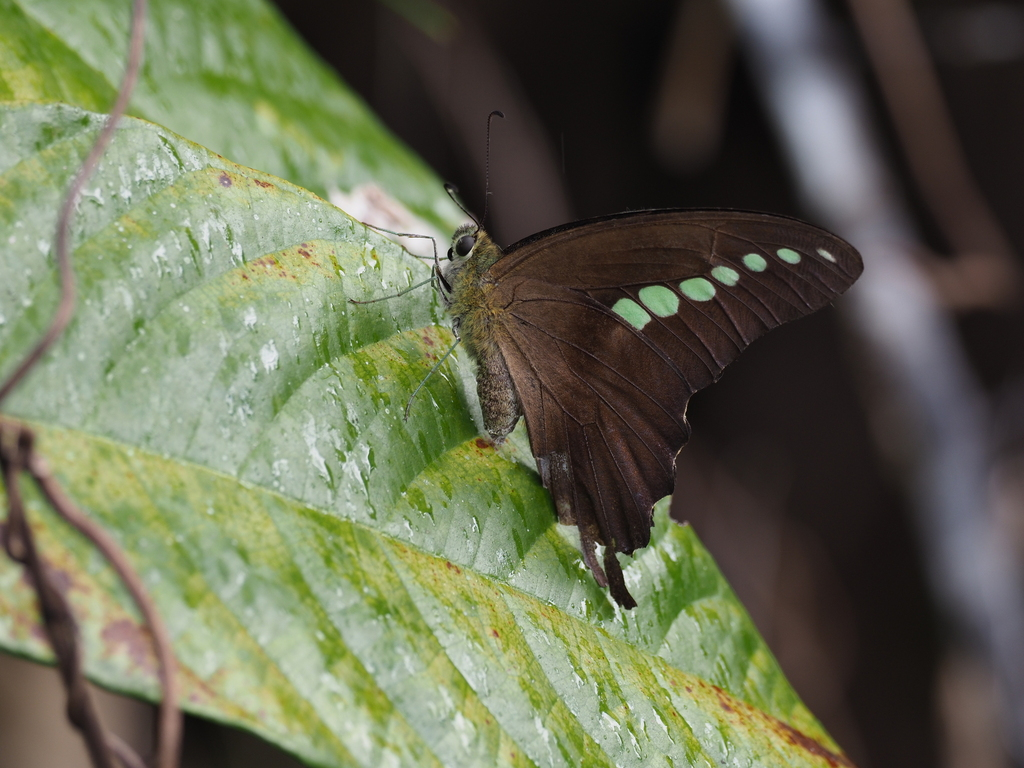This week's Graphium is a black or sable Swallowtail with a row of pale green or yellow dots down each wing. The shape and color of the dots can remind people of jellybean candies. Some online sources call Graphium codrus the Green Jellybeans Butterfly. Soberer writers call it the Green-Banded Kite. Some writers call it the Green or Eastern Olive Triangle, because its colors can be olive drab and olive green, it lives east of Britain, and it's in the family called Triangles. A few call it the Ghost, or even the Zombie, because its wings have an unusual whitish gloss that positively glows in the light.
Photo donated to Wikipedia By Tokalabo - Own work, CC BY-SA 3.0, https://commons.wikimedia.org/w/index.php?curid=26573204.
To researchers it looks like a bad photo until we notice that photos of this species all tend to look "bad" in the same way. Even dead museum specimens reflect light. In real life some people see Graphium codrus as ghostly. It likes to fly through patches of sun in forests, and may drop suddenly from the sky onto a flower. Its wingspan is usually over three inches. Obviously this butterfly is not easy to ignore.
Photographs of it are abundant on the Internet, although unfortunately the great majority of photos of this species that Google is willing to display come from sites that claim to trade in dead bodies. It has even appeared on coins--as in Vanuatu, where they were experimenting with stamping colored pictures onto coins. I found no photo of a living butterfly that had such a bright coppery glow, though they can look brown with amber or pale orange spots. I think the copper tone of the one on the coin has something to do with the amount of copper in the metal.
The glossy reflective effect is, like other butterflies' color patterns, produced by the tiny scales that cover butterfly wings. Codrus scales don't have a distinctive color but come in distinctive shapes that reflect light in that almost fluorescent way. Most of the Graphiums have scales that iridesce, showing different colors at different angles; sarpedon and weiskei have pigmented scales, and codrus has reflectors.
Fifteen subspecies are currently recognized: auratus, celebensis, codrus, gilolensis, medon, melanthus, noeli, pisidice, schoutensis, segonax, stiris, taloranus, tenebrionis, toealensis, and yayoeae. An early description of each subspecies, not necessarily in English, and a list of places where it's found, is available at
It seems almost as if each island habitat tends to produce its own typical color patern. All Graphium codrus have dark wings with a band of bright light colored spots and that patch of glowing reflective scales on the inner hind wings. Usually they reflect silvery white; sometimes some butterflies reflect greenish, yellow, or reddish. In some individuals the basic color of the wings might be described as dark olive drab, with light olive green spots.
Photo by Lisa James. This individual is thought to belong to the subspecies medon.
A subspecies lawlencei, according to Adam Cotton, has never been formally described to scientists and properly named; it's a fake or at least unofficial variation described only at web sites that purport to sell dead bodies of butterflies. Apparently several subspecies have been described only by and for this industry.
This butterfly is found in the Philippines and nearby islands. It can live on a few different kinds of trees, all with five-lobed leaves, in the genera Annona, Fernandia, and Uvaria. It spends much of its time flitting among the tops of these trees, occasionally coming down (with startling speed) to sip fruit juice, flower nectar, or water.
Photo by A.S. Kono. Graphium codrus is primarily a pollinator species, especially of some wild flowers and salvias, lantanas, and hibiscus as well as its host trees. It gets nutrients from salt water and is often found at puddles on beaches.
Photo by Hdemann. Only a few photos show that it's not that photographers are unable to focus on codrus, but that codrus wings scatter light in a way that makes it look as if they were.
The life cycle of this species seems undocumented on the Internet.
Photo from Collector-secret. The caterpillar is trying to look like a damaged leaf with thorns; its little spines are not very sharp or dangerous to humans, who don't think it looks edible anyway. (Nor is it. The leaves it eats have emetic properties.)
Pupae are said to be light green, like other Graphium pupae, but to have a rounder shape without the sharp angles and points observed on some other species in this genus.









No comments:
Post a Comment